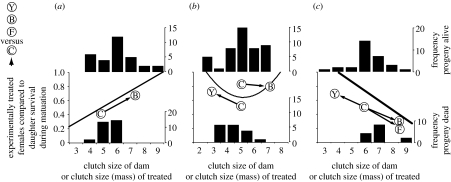Figure 2.
Comparison of survival selection on clutch size as detected with manipulations (arrows) and genetic correlations (regression lines). Arrows indicate change in probability of maturational survival (left axis) as a function of mean change in clutch size (number of eggs, x-axis) for experimental compared with control groups (Y, yolkectomy of follicle (i.e. ablation); B, Corticosterone implant; F, FSH implant; C, sham-manipulated control; in 1992 two control groups are shown: follicle ablation controls and corticosterone implant controls). The thick regression lines indicate the relationship between maturational survival probability of daughters (abscissa) as a function of dam's clutch size (ordinate), which is indicative of an underlying genetic correlation between the fitness traits clutch size and survival. Histograms depict the frequency distribution of daughters that survived (fitness=1, top histograms) or died (fitness=0, bottom histograms) during maturation as a function of the mother's clutch size. Based on these changes in frequency distribution, significant directional selection (p<0.05, solid line) favoured survival of female offspring in (a) 1991 whose mother produced large clutches the previous year. Significant disruptive selection on female offspring in (b) 1992 favoured female offspring whose mother produced either large or small clutches and selectively eliminated those female offspring whose mother produced intermediate-sized clutches the previous year. Significant directional selection (solid line) favoured survival of female offspring in (c) 1993 whose mother laid a small clutch the previous year.

